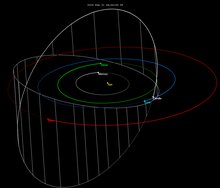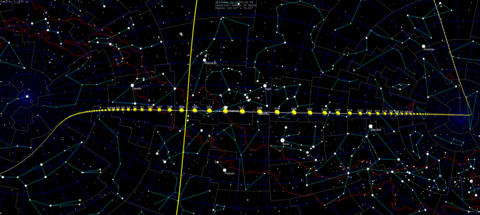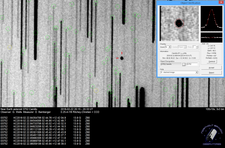 Radar image of Camillo taken by the Arecibo Observatory on 21 February 2018, revealing its angular bilobate shape Radar image of Camillo taken by the Arecibo Observatory on 21 February 2018, revealing its angular bilobate shape | |
| Discovery | |
|---|---|
| Discovered by | E. F. Helin M. Barucci |
| Discovery site | CERGA Obs. |
| Discovery date | 15 August 1985 |
| Designations | |
| MPC designation | (3752) Camillo |
| Pronunciation | /kəˈmɪloʊ/ |
| Named after | Camillo (son of King Turno and son of discoverer) |
| Alternative designations | 1985 PA |
| Minor planet category | NEO · Apollo |
| Orbital characteristics | |
| Epoch 23 March 2018 (JD 2458200.5) | |
| Uncertainty parameter 0 | |
| Observation arc | 42.26 yr (15,436 d) |
| Aphelion | 1.8400 AU |
| Perihelion | 0.9871 AU |
| Semi-major axis | 1.4135 AU |
| Eccentricity | 0.3017 |
| Orbital period (sidereal) | 1.68 yr (614 d) |
| Mean anomaly | 41.249° |
| Mean motion | 0° 35 11.4 / day |
| Inclination | 55.555° |
| Longitude of ascending node | 147.98° |
| Argument of perihelion | 312.22° |
| Earth MOID | 0.0780 AU (30.3871 LD) |
| Physical characteristics | |
| Mean diameter | 2.3 km (approx.) 2.306±0.088 km 2.328 km 2.33 km (taken) |
| Synodic rotation period | 37.846 h 37.881±0.005 h |
| Geometric albedo | 0.210±0.036 0.22 0.2234 |
| Spectral type | S (assumed) |
| Absolute magnitude (H) | 15.3 · 15.41 · 15.41±0.13 · 15.5 |
3752 Camillo is an inclined contact-binary asteroid, classified as near-Earth object of the Apollo group, approximately 2.3 kilometers (1.4 miles) in diameter. It was discovered on 15 August 1985, by astronomers Eleanor Helin and Maria Barucci using a 0.9-metre (35 in) telescope at the CERGA Observatory in Caussols, France. Lightcurve studies by Petr Pravec in 1998 suggest that the assumed S-type asteroid has an elongated shape and a longer-than average rotation period of 38 hours.
Orbit

Camillo orbits the Sun at a distance of 0.99–1.8 AU once every 20 months (614 days; semi-major axis of 1.41 AU). Its orbit has an eccentricity of 0.30 and an inclination of 56° with respect to the ecliptic.
Close approaches
The closest point between the orbit of the Earth and the orbit of this asteroid (Earth MOID) is currently 0.0780 AU (11,670,000 km; 7,250,000 mi) or 30 lunar distances, so Camillo does not come close enough to Earth to qualify as a potentially hazardous asteroid. It came to perihelion (its closest approach to the Sun) on 6 January 1976 and, on 17 February 1976 and passed within 0.08013 AU (11,987,000 km; 7,449,000 mi) of Earth.
2013 passage
Camillo came to perihelion on 27 December 2012. On 12 February 2013 the asteroid passed 0.14775 AU (22,103,000 km; 13,734,000 mi) from Earth and had an apparent magnitude of 13. During the 2013 passage the asteroid was studied by radar using Goldstone and Arecibo.
 Camillo's south to north daily motion in the sky as seen from the earth |
2018 passage
On February 20, 2018, the asteroid passed by Earth. It was observed on radar by Arecibo Observatory and shown to have a long angular double-lobed shape. At 0.13 AU (19,000,000 km; 12,000,000 mi) distance its peak magnitude was about 13.
 Camillo's south to north daily motion in the sky as seen from the earth |

 Left: A 25 minute timelapse sequence of 3752 Camillo taken from Northolt Branch Observatories (London, UK) on 22 February 2018, two days after closest approach. The asteroid can be seen at apparent magnitude +14, moving upwards through the image. Brightness is inverted (stars appear dark, the sky background appears light). Camillo was about 21.9 million km (13.6 million mi) from Earth at that time. Right: Camillo as seen from Northolt Branch Observatories on 22 February 2018. The image is corrected for the asteroid's motion, so stars appear trailed.
Left: A 25 minute timelapse sequence of 3752 Camillo taken from Northolt Branch Observatories (London, UK) on 22 February 2018, two days after closest approach. The asteroid can be seen at apparent magnitude +14, moving upwards through the image. Brightness is inverted (stars appear dark, the sky background appears light). Camillo was about 21.9 million km (13.6 million mi) from Earth at that time. Right: Camillo as seen from Northolt Branch Observatories on 22 February 2018. The image is corrected for the asteroid's motion, so stars appear trailed.
Naming
This minor planet was named for the son of the early Roman King Turno. "Camillo" is also the name of the discoverer's son. The official naming citation was published by the Minor Planet Center on 20 May 1989 (M.P.C. 14633).
References
- ^ "3752 Camillo (1985 PA)". Minor Planet Center. Retrieved 10 May 2018.
- ^ Schmadel, Lutz D. (2007). "(3752) Camillo". Dictionary of Minor Planet Names – (3752) Camillo. Springer Berlin Heidelberg. p. 317. doi:10.1007/978-3-540-29925-7_3749. ISBN 978-3-540-00238-3.
- ^ "JPL Small-Body Database Browser: 3752 Camillo (1985 PA)" (2018-05-03 last obs.). Jet Propulsion Laboratory. Retrieved 10 May 2018.
- ^ Lance A. M. Benner (15 November 2012). "3752 Camillo Goldstone Radar Observations Planning". NASA/JPL Asteroid Radar Research. Retrieved 23 November 2012.
- ^ Mainzer, A.; Grav, T.; Masiero, J.; Hand, E.; Bauer, J.; Tholen, D.; et al. (November 2011). "NEOWISE Studies of Spectrophotometrically Classified Asteroids: Preliminary Results". The Astrophysical Journal. 741 (2): 25. arXiv:1109.6407. Bibcode:2011ApJ...741...90M. doi:10.1088/0004-637X/741/2/90. S2CID 35447010. (catalog)
- ^ Mainzer, A.; Grav, T.; Bauer, J.; Masiero, J.; McMillan, R. S.; Cutri, R. M.; et al. (December 2011). "NEOWISE Observations of Near-Earth Objects: Preliminary Results". The Astrophysical Journal. 743 (2): 17. arXiv:1109.6400. Bibcode:2011ApJ...743..156M. doi:10.1088/0004-637X/743/2/156. S2CID 239991.
- ^ Pravec, Petr; Harris, Alan W.; Kusnirák, Peter; Galád, Adrián; Hornoch, Kamil (September 2012). "Absolute magnitudes of asteroids and a revision of asteroid albedo estimates from WISE thermal observations". Icarus. 221 (1): 365–387. Bibcode:2012Icar..221..365P. doi:10.1016/j.icarus.2012.07.026.
- ^ "LCDB Data for (3752) Camillo". Asteroid Lightcurve Database (LCDB). Retrieved 10 May 2018.
- ^ Pravec, Petr; Wolf, Marek; Sarounová, Lenka (November 1998). "Lightcurves of 26 Near-Earth Asteroids". Icarus. 136 (1): 124–153. Bibcode:1998Icar..136..124P. doi:10.1006/icar.1998.5993.
- Hanus, J.; Durech, J.; Oszkiewicz, D. A.; Behrend, R.; Carry, B.; Delbo, M.; et al. (February 2016). "New and updated convex shape models of asteroids based on optical data from a large collaboration network". Astronomy and Astrophysics. 586: 24. arXiv:1510.07422. Bibcode:2016A&A...586A.108H. doi:10.1051/0004-6361/201527441. S2CID 119112278.
- "Radar images of 3752 Camillo". Arecibo Observatory (on Twitter). 21 February 2018.
- Wells, G.; Bamberger, D. (22 February 2018). "3752 Camillo". Northolt Branch Observatories. Retrieved 10 May 2018.
- Wells, G.; Bamberger, D. (22 February 2018). "Near Earth asteroids 2017 VR12, 3752 Camillo, 2018 CU1 and 2018 DA". Northolt Branch Observatories. Retrieved 10 May 2018.
- "MPC/MPO/MPS Archive". Minor Planet Center. Retrieved 10 May 2018.
External links
- Asteroid Lightcurve Database (LCDB), query form (info Archived 16 December 2017 at the Wayback Machine)
- Dictionary of Minor Planet Names, Google books
- Asteroids and comets rotation curves, CdR – Observatoire de Genève, Raoul Behrend
- 3752 Camillo at NeoDyS-2, Near Earth Objects—Dynamic Site
- 3752 Camillo at ESA–space situational awareness
- 3752 Camillo at the JPL Small-Body Database

| Minor planets navigator | |
|---|---|
| Small Solar System bodies | |||||||
|---|---|---|---|---|---|---|---|
| Minor planets |
| ||||||
| Comets | |||||||
| Other | |||||||